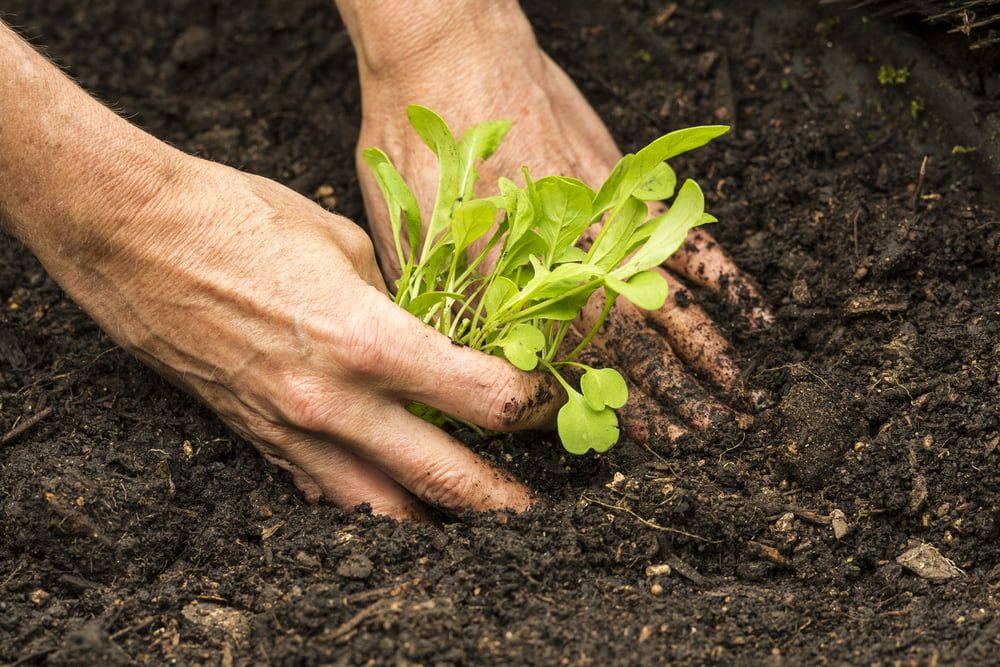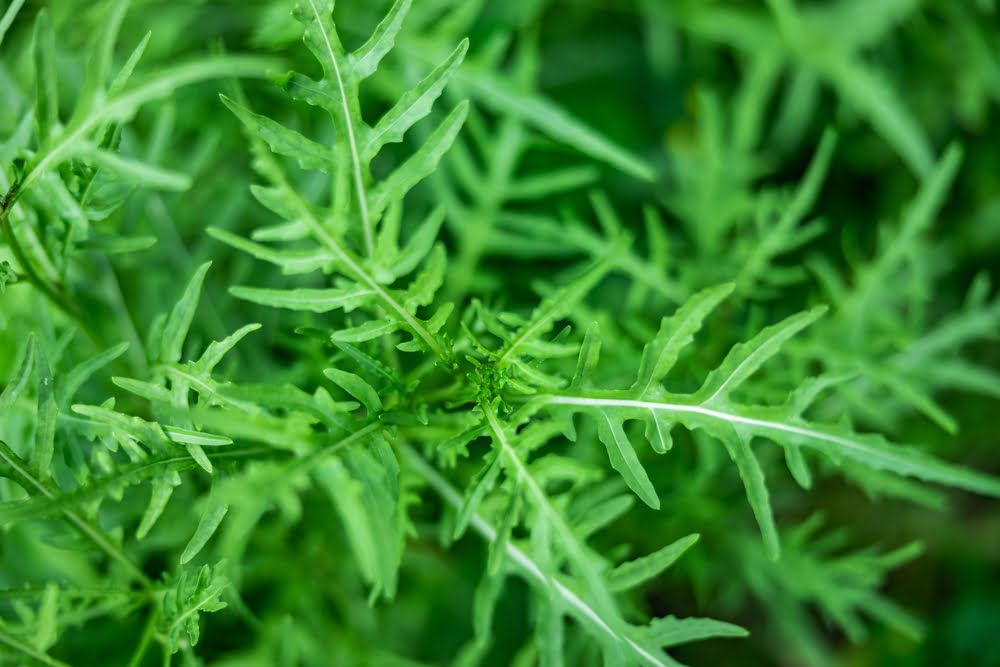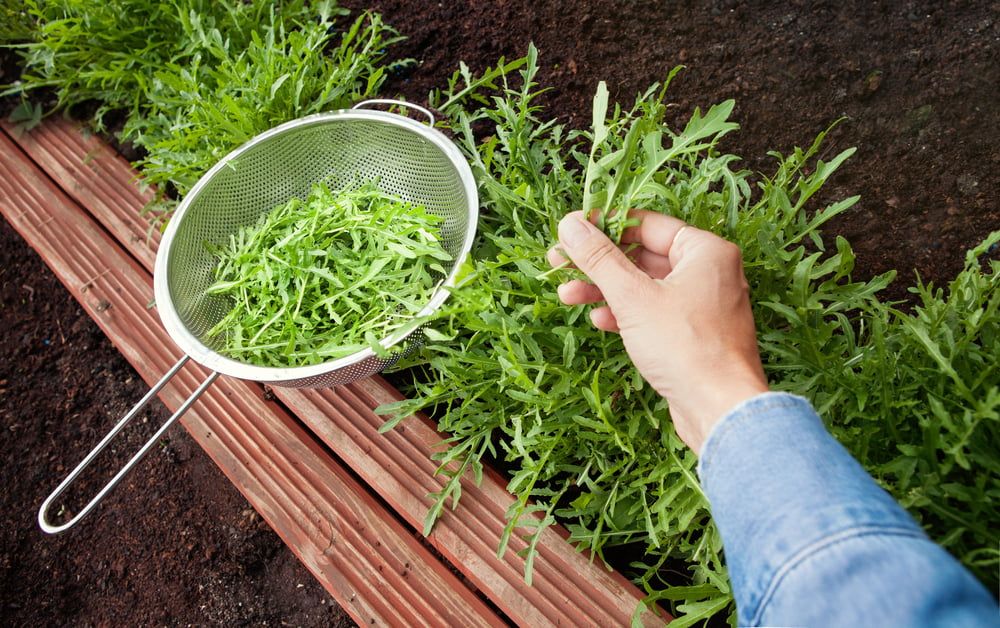
Punchy, peppery, and delicious both raw and cooked, rocket tends to be a vegetable garden favourite. Even better, it’s extremely easy to grow – sow your seeds successionally and you could be harvesting rocket leaves for the majority of the year.
Growing Rocket: A Quick Snapshot
When to Sow – Feb-Sep
When to Plant – Apr-Oct
When to Harvest – May-Dec
Average Yield per Plant – 40g
Spacing – 15cm
Depth – 0.5cm
How to Grow Rocket at Home
If you’ve never grown rocket before but have seen the price of commercially-produced rocket on supermarket shelves, it would be easy to think that this was a difficult crop to cultivate. However, this cool season leafy green is a fast-grower that doesn’t ask for much – provide it with the basics and you’ll soon be enjoying regular harvests.
Growing Requirements for Rocket
Rocket does well in both full sun and partial shade. However, it’s important to take your climate into account when choosing a growing location. Too much heat in combination with full sun will cause your plants to bolt before you’ve had the chance to harvest them. If you live in a hot climate, give your plants some afternoon shade.
In terms of soil, rocket isn’t fussy. It prefers a well-draining mix, but will happily grow in just about anything, with the exception of heavy clay.
One thing to keep in mind is that rocket is a member of the brassica family. In order to prevent diseases from building up, try to avoid growing it in an area that recently grew another brassica.
How to Grow Rocket from Seed
Rocket grows quickly from seed and is a great plant to successionally sow. Aim for about five plants per person in your household, and sow enough seeds to provide this every two weeks.
While rocket does well when direct-sown, late frosts can decimate tender young seedlings. For this reason, most gardeners sow an early crop of seeds under cover, before moving later sowings outside.
How to Sow Rocket Seeds in Modules:
- Fill module trays with a multi-purpose compost
- Water the compost well
- Sow your rocket seeds over the surface of the compost. Aim for about five seeds per module
- Cover the seeds over with light layer of compost – they only need to be about 0.5cm deep
- Water lightly again
- Place your trays somewhere warm. Although rocket will germinate in temperatures as cool as 5°C, somewhere between 15-20°C allows for optimum germination
It usually takes less than a week for rocket seeds to germinate. Once they do, move your trays somewhere bright and keep your seedlings moist. Thin your seedlings out so that there’s just one in each module.
How to Direct Sow Rocket Seeds:
- Thoroughly weed your growing area
- Create a shallow furrow in the ground, about 0.5cm deep
- Sow your rocket seeds thinly along this. Aim for about 3cm between each seed (you’ll be thinning them out in a few weeks time)
- Cover your seeds back over with soil
- If the ground is dry, give it some water
Once your rocket seeds germinate, give the seedlings a couple of weeks to grow before thinning them out to a final spacing of 15cm.
How to Plant Rocket Outside
Once you’ve had your last spring frost, your indoor-sown rocket seedlings can be planted outside. However, before you do this, you’ll need to harden your seedlings off for a week to help prevent transplant shock.
Once your seedlings have acclimatised to outdoor conditions, prepare your growing area, making sure that it’s weed-free. Dig small holes in the ground, about 15cm apart. Don’t be tempted to go for a smaller spacing – overcrowding your rocket plants will cause them to bolt. The holes that you dig don’t need to be too big – just slightly wider and deeper than the root balls of your seedlings is ideal.
Be very careful when removing your seedlings from their modules. Rocket produces a long and thin taproot – damage this and your plants will struggle to establish. Remove as much of the soil surrounding the roots as possible, and place the entire root ball into its new home. Cover over with soil, gently firm down, and then give your seedlings some water.
How to Plant Rocket in a Greenhouse
Rocket does well in a greenhouse during the cooler months of the year. A greenhouse enables you to harvest your plants earlier in the spring, and can extend autumn harvests well into the winter. However, a greenhouse isn’t great for summertime harvests – the heat causes the plants to bolt.
When planting rocket in a greenhouse, use the same methods as when planting outside.
You could also consider growing your rocket in pots. Sow your seeds directly into larger containers but keep them in your greenhouse until the weather warms up. If you decide to do this, go for containers that are at least 10-15cm deep.
How to Care for Rocket
Rocket doesn’t require much in terms of care. However, if you want your plants to be as bushy as possible and don’t want to deal with bolting, a little extra attention is always helpful:
Watering Rocket
Rocket needs to be kept consistently moist in order for those leaves to retain their flavour. Ideally, water your plants whenever the top 3cm of soil feels dry. This could mean daily, or even twice-daily, waterings during the summer, compared to watering just once or twice a week in the autumn.
Try to water your rocket as consistently as possible to prevent your plants from bolting.
Feeding Rocket
Although rocket doesn’t need a fertiliser, feeding your plants once or twice during the growing season can help to encourage leafy growth. However, don’t go overboard with this as too much fertiliser will affect flavour.
Ideally, give your growing area some well-rotted animal manure either before or just after planting your rocket out. You could also apply an organic, general-purpose fertiliser, such as liquid seaweed, a month or so into the growing season.
Weeding and Mulching Rocket
Rocket doesn’t grow particularly large or bushy, meaning that weeds can quickly smother young plants out. In order to give your plants the best chance, you’ll need to keep their growing area weed-free.
To save yourself from hours of back-breaking weeding, consider laying a mulch around your rocket plants. Use an organic mulch, as this will also feed your soil as it breaks down.
Pinching Off Flower Buds
After your rocket plants have been growing for a while, they’ll start to produce flower buds. This is a sign that your plants are coming to an end – they’ll focus all of their energy on producing flowers and seeds, at the expense of leaves. The leaves are still edible once the plants have flowered, but they’ll be much tougher and more bitter.
One way to extend your harvesting period is to pinch off any flower buds that appear. Ideally, do this before the flowers actually open up.
However, don’t worry if you miss your chance and you find your rocket plants covered in white flowers. Those flowers have a very similar taste to the leaves and can be used as a peppery garnish for dishes. Plus, if you’ve been sowing your seeds successionally, your next batch of rocket plants should now be ready for harvesting.
How to Harvest Rocket
Rocket is usually ready to be harvested about 4-6 weeks after sowing. That said, you may be able to snip off younger leaves before this.
Either way, harvest the leaves as and when needed. Pick a few leaves from each plant, rather than completely stripping a single plant, which would inhibit growth. The more you pick the leaves, the more leaves your plants will produce.
How to Store Rocket
Just like other salad greens, rocket can be a little tricky to store. One popular method is to line an airtight container with paper towels. Then, wash and dry the rocket before placing it into the container, and then storing the container in the fridge. The paper towels will help to absorb any moisture that the leaves release, keeping them good to use for up to four days.
If long-term storage is what you’re after, consider freezing your harvest. Keep in mind that, no matter how well you prepare them, the leaves will still be pretty mushy once defrosted. This doesn’t mean that they can’t be used – they’ll still be great for pestos and cooked dishes, but won’t have the right texture for a salad.
To freeze rocket leaves, start by washing and drying them. Then, lay them onto a flat tray and flash freeze them for a few hours. Once the leaves have frozen, move them into an airtight bag or container. They’ll keep in the freezer for 3-6 months.
How to Prepare & Cook Rocket
Rocket doesn’t require much preparation. Simply wash and dry the leaves and they’re ready to be used.
One of the most common ways to use rocket is in salads. It’s usually mixed in with other salad greens, but works well as the main ingredient too. However, there are only so many salads that a person can eat. If you want to get creative and use your rocket harvest in other ways, a few ideas include:
- Rocket and basil pesto
- Rocket and chickpea hummus
- Rocket and beetroot fritters
- Rocket as a pizza topping
- Rocket soup
Keep in mind that tender leaves taste best when eaten fresh and raw. However, older leaves can be tougher, so processing them in some way will make them much more palatable.
Common Rocket Problems
There aren’t too many pests and diseases that plague rocket, which is why this plant is considered to be such an easy one to grow. However, no plant is problem-free, so keep an eye out for the following issues:
- Flea beetle – the most common rocket pest, flea beetles will munch small holes in your leaves, with the damaged areas soon turning brown. They’re not such a problem with mature plants (any leaves that they have feasted on are still edible), but will completely decimate seedlings. Keeping your plants covered with fleece or a cloche can prevent flea beetle damage, while a nitrogen-rich fertiliser will give your plants the boost that they need to defend themselves
- Aphids – another common garden pest, aphids are tiny bugs that gather on the undersides of leaves. They’ll suck the sap from your plants, distorting them and inhibiting growth. A strong jet of water is often enough to dislodge a small infestation, and there are plenty of organic remedies out there for larger clusters
- Bolting – bolting has been mentioned several times already – rocket plants love to bolt as soon as conditions become less-than-desirable. Too much heat, too much cold, too much (or too little) moisture, lack of ventilation – all of this and more triggers bolting. Other than giving your plants the right conditions and pinching off any emerging flower buds, there’s not much else that you can do to prevent bolting. This is another reason why it’s important to successionally sow rocket, as you’ll then always have new plants ready to replace any that have bolted
Popular Rocket Varieties to Grow
There are more than 20 different rocket varieties to choose from. They each vary slightly in flavour and appearance, but can be grown using the same methods. It’s always worth trying a few different varieties to see which ones do best in your garden. Some of the best varieties to start off with are:
- Astro – much milder and less peppery than other varieties
- Italian Cress – has much larger, lettuce-like leaves than other varieties, meaning that you don’t need quite as many to bulk out a dish
- Red Dragon – although slow-growing, this variety has beautifully serrated leaves with striking red veins running through them, making them extremely attractive
- Slow Bolt – a heirloom variety that happens to be bolt-resistant
- Wasabi – a variety that boasts a very strong and pungent kick
- Wild Rocket – tends to be spicier than most varieties. If you live in the right climate, this variety can be grown as a perennial
Conclusion
Rocket is such a flavourful crop – just a few leaves are enough to transform a meal. It also happens to be packed with vitamins and other key nutrients, making it a food that’s well worth eating more of. The fact that rocket is so easy to grow is definitely a bonus – time things right and not only will you be harvesting rocket throughout the spring and summer, but you can also store your harvests to feed you well into the winter.







